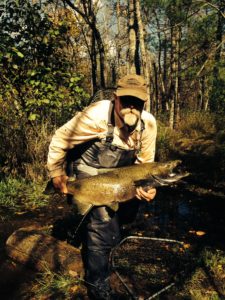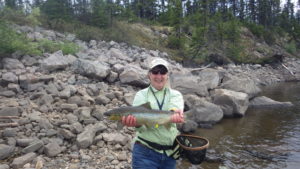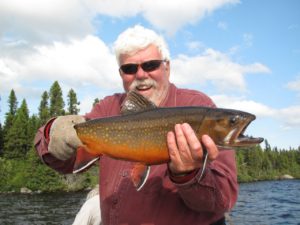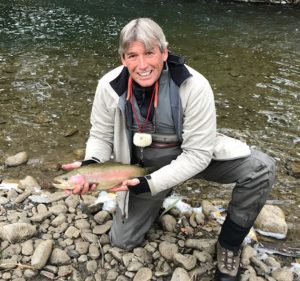Last week, this column followed the remarkable trip of Rex Channell and his wife Trish Watson across Canada. Readers may recall that they traveled in their 25-foot Coachman Freelander (aka FISHlander) and camped and fished all across Canada. Let’s pick up the trip when they crossed back into the USA from British Columbia, Canada.
Passing into Idaho, they stopped to visit Matt Sawyer former Marketing Director of Butternut Ski Area in Great Barrington who now works at Lookout Pass Ski Area in Idaho. For the next several days they fished such famous rivers as the Coeur D’Alene, Little St Joe and Quartz Creek with Matt, also an avid fisherman, as their guide.
Then onto Montana where on August 8, they visited two different former Berkshire County ski friends in the Whitefish, Montana area – Emily Goodrich and Paul Descouteau. There was a very real wildfire threat in the Flathead area of Montana, especially in Seeley Lake where active firefighting was prominently visible. Instead they fished Livingston, MT – the Little Blackfoot River, Yellowstone River and Boulder River – which offered up cutthroat, rainbow and browns of various sizes. They splurged on a float trip on the Yellowstone River with Montana Trout Anglers and had a very successful trip catching healthy (1-2 lb) rainbows and browns.
They crossed into Wyoming on August 18 through the very crowded Yellowstone and Great Teton National Parks at the height of the tourist season. They stopped in to see former Berkshire-ites, Jonathan Gray in Jackson, WY and Celeste Young in Victor ID and visited the Jackson National Fish Hatchery (Snake River cutthroat). On recommendation of several local guides, they trekked the 15-mile dirt road up the Grey’s River out of Alpine, WY. There, they experienced the spectacular solar eclipse on the Grey’s River with only a herd of ranch cattle as company. Unfortunately, the fishing was pretty slow with only a couple of Snake River cutties netted in the three days.
So back in Alpine, they took another guided float trip, this time on the Salt River with Pioneer Anglers Fly Shop. It was an evening float that started at 3:00 pm and lasting until dark with continuous surface action using big hopper patterns and producing a lot of Snake River cutthroat several in the 2+ lb range. On their way through central and southeastern Wyoming, they visited the Museum of the Mountain Man in Pinedale and the Saratoga National Fish Hatchery (primarily lake trout). They saw several enticing rivers (e.g. North Platte) and alpine lakes (e.g. Lake Marie in the Snowy Range of the Medicine Bow National Forest) but left them to fish another trip as they were making their way to Colorado to meet up with relatives in a few days. At an over-night in Laramie, Wyoming, they camped in the Prairies Lake region and tried fishing from shore on the Gelatt and Twin Butte Lakes with no luck.
On August 25 and 26, they traveled to Boulder and Castle Pines, Colorado to visit friends and family sightseeing in the Garden of the Gods and the Red Rocks parks. In Salida, one of their favorite places in Colorado, they stayed near Chalk Creek for three days and fished Wright’s and Chalk Lakes catching lots of rainbow trout in the 10”-14” range on size 2 to 10 terrestrials. And they visited three Colorado State Fish Hatcheries – Mt Shavano (kokanee salmon, Snake River cutthroat, rainbow and cutbow), Chalk Creek (rainbow) and Roaring Judy (kokanee salmon, cutthroat, rainbow).
Rex and Trish spent the next 12 days in southern Colorado, visiting transplanted friends, taking in the sights and fishing some great areas. In the Gunnison area, they fished Cement Creek, Spring Creek and Taylor Reservoir for small browns and brookies. They toured the Ross Reel factory in Montrose. They fished the San Miguel River outside of Ridgeway catching rainbows on dries against straight red-rock cliffs. From Ouray, “the Switzerland of America”, they took the Million Dollar Highway which traverses three passes over 10,000 feet high in 57 miles ending up in Durango where they fished the Lemon Reservoir and Florida River.
They spent the next week in Utah visiting the national parks and monuments – Arches, Canyon Lands, Capital Reef, National Bridges, Glen Canyon, Bryce Canyon and Zion. In Moab, they went off-roading to fish the small alpine Oowah Lake. While marveling at the landscape, they took plenty of time to fish the southern Utah area around Loa hiring guide/owner Mike James of the Quiet Fly Fisher who gave them a diverse sampling of river, lake and reservoir. Both Rex and Trish were successful catching tiger trout in the 3 lb category with a size 16 imitation boatman fly. Some of the waters they sampled both with Mike and on their own include the Fremont River, Ferris Lake, Forsyth Reservoir, Bicknell Bottoms, Boulder Mountain Reservoir, Garcane Power Plant Reservoir, Boulder Creek, and Upper East Boulder Reservoir catching tiger, rainbow and brook trout. In Bicknell, they visited the J Perry Egan State Fish Hatchery (brook, rainbow and lake trout).
They spent 4 days in Arizona (9/18 – 9/21) to see the north rim of the Grand Canyon – so awe-inspiring – and to visit an aunt and uncle in Phoenix. However, it was still very warm (highs above 100°) so they decided to go back into the mountains of Colorado as soon as possible. Passing back into Colorado, they stopped at Mesa Verde National Park. On 9/23-9/24, they stayed at the Elk Trace B&B, a working ranch in Pagosa Springs, CO, to celebrate their 34th wedding anniversary fishing (naturally) this time in the nearby Williams Creek and Reservoir.
They spent several days in Mogote, CO, to fish the Conejos River, a river they had fished a few years ago. They stayed at the dispersed wilderness site at Elk Creek since Colorado state campgrounds had been closed since mid-September. They took a day trip with Conejos River Anglers and landed a lot of 16”-20” browns using size 20 and smaller nymph patterns with a double dropper rig. On the way east, they fished the Arkansas River at several pull-offs along US 50 through Canyon City and into West Pueblo but had no luck. The last stop they made in Colorado was to the Pueblo Weisbrod Aircraft Museum, incredible collection of aircraft from the last 120 years.
Now in the plains states, Rex and Trish were interested in laying down some miles. They quickly passed through Kansas and Missouri. They visited Boot Hill Museum and Front Street, Dodge City, KS as a fun diversion from driving. And they took a detour to Branson, MO, to visit Dolly Parton’s Dixie Stampede – good, clean entertainment. They visited relatives outside of St. Louis, MO and friends in Indianapolis, taking in the Indianapolis Motor Speedway and the Indianapolis Zoo.
On October 5 they finally made it into Michigan. Their first stop was to the Richard Clay Bodine State Fish Hatchery (brood stock for steelhead). In Spring Lake, they visited
Nick Petrinec who took them out on the Muskegon River in his Jet boat. They spent several days fishing, first the Pere Marquette River in Baldwin, catching big king salmon using egg patterns and grey mop flies, then the Manistee River at the Hodenpyl Dam in Mesick, Michigan netting several 10”-12” rainbows using Adams nymphs and stimulator dries and finally, the North and South Forks of the AuSable River in Grayling, where they were skunked. They made one more stop in Michigan to visit ski friends – Cheyanne Sawyer (the daughter of Matt from Idaho) – at Boyne Mountain Ski Area. They traversed the Upper Peninsula before crossing back into Canada at Sault Ste Marie, taking in Niagara Falls on the Canadian side.
They arrived home on October 20 after discovering that all campgrounds and RV parks were closed in the northeast leaving only Walmart Parking lots as places to camp.
They were gone some 164 days, of which 96 of them were spent fishing. They traveled through 8 Canadian provinces, 17 states, traveling 16,708 miles. They visited 7 fish hatcheries, and if you are wondering why, they have a special place in their heart for them. They were married in one.
What an amazing trip! They hope to have a video program of the trip early in 2018, with the locations and times to be determined at a later date.
But wait! You might think they would be tired of camping and fishing by then, but guess what. On October 23, they did some wilderness camping on the Deerfield River in Charlemont, MA and Trish caught the pictured 20- inch plus brown trout!
Ice Fishing
With this serious cold snap, some hard water anglers will be heading out onto the ice to do some ice fishing. There may be enough ice, especially in the higher elevations, but be careful in the lower elevations. You might want to stay away from any stream inlets or areas where there are currents which will have thinner ice. MassWildlife has some ice thickness guidelines, be sure to check them. Simply search “Stay Safe on Ice”, on its web page.
The last weather forecast that I saw mentioned temperatures in the 5 below zero area. Keep a sharp eye on the youngsters so that they don’t get frostbitten hands and feet. If you go, don’t forget to bring your 2018 fishing license.
Personally, I love to ice fish, but I’m going to wait another week, just to be on the safe side.





